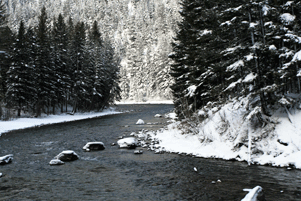
 After about 4 feet of new snow in the last 2 weeks, ski season went out with a bang. Well, it’s not over yet – Big Sky resort closes on Easter – but it is for me, yesterday was my last day on the mountain and boy did I have fun in the powder with some K2 phat luvs. I know spring is coming and all – but I have to say that I’m a bit sad that winter is over (a reminder, for those of you wondering what is wrong with me: I live in Montana. I love snow and the winters here aren’t dreary, they are glorious and snowy and sunny). My ski days have been not only getting out to enjoy the alpine air and exercise, but also doubled as dates with husband. So the somewhat sad wistfulness I’m feeling at the season’s end has got me pondering the significance of the change in seasons. Most people who aren’t big fans of winter are now relishing the arrival of spring; but every season brings shifts and changes that can cause us to feel unsettled, if we’ve gotten comfortable in our seasonal routines. We get attached and it’s hard to let go (i.e., perhaps it’s time to take down the Christmas lights in Morgane’s room…?)
After about 4 feet of new snow in the last 2 weeks, ski season went out with a bang. Well, it’s not over yet – Big Sky resort closes on Easter – but it is for me, yesterday was my last day on the mountain and boy did I have fun in the powder with some K2 phat luvs. I know spring is coming and all – but I have to say that I’m a bit sad that winter is over (a reminder, for those of you wondering what is wrong with me: I live in Montana. I love snow and the winters here aren’t dreary, they are glorious and snowy and sunny). My ski days have been not only getting out to enjoy the alpine air and exercise, but also doubled as dates with husband. So the somewhat sad wistfulness I’m feeling at the season’s end has got me pondering the significance of the change in seasons. Most people who aren’t big fans of winter are now relishing the arrival of spring; but every season brings shifts and changes that can cause us to feel unsettled, if we’ve gotten comfortable in our seasonal routines. We get attached and it’s hard to let go (i.e., perhaps it’s time to take down the Christmas lights in Morgane’s room…?)
Interestingly enough I picked up a book last night that I check in with now and then, it’s a lovely collection of essays on nature called Awake in the Wild – Mindfulness in Nature as a Path of Self-Discovery. And almost as if on cue, I opened up to this essay: “Embracing the Changing Seasons”. Here are some reflections to keep in mind during seasonal shifts, to help us to embrace each one for what it has to offer us:
Nature teaches us that to hold on is to suffer. No matter how much we adore the bluebells in the woods in spring, or the flowering acacia trees in summer, to become attached to them is futile. Of course, that knowledge doesn’t always hinder our resistance to letting go. We begin to let go only when we see the pain that’s caused by holding on…
We all have favorite times of day, preferred weather, and attachments to different seasons. However, if things always stayed the same, we would appreciate them less. It is partly the very nature of transience that makes this world, and each singular thing in it, so special and precious. If a sunset lasted a week, would we care about it as much?
The deeper we are attuned to the natural world, the more our being begins to register the march of time. Every day there are noticeable yet subtle shifts in the seasons, in the light, temperature, humidity, and foliage. The blooming of flowers and color of leaves indicate the passing of time. Nature keeps telling us that there is only flow, change, metamorphosis. We can either join the flow of the river or try swimming upstream. One way is infinitely easier.
Embracing the changing seasons teaches us about equanimity, a state of heart that does not struggle against the way things are. Equanimity is grounded in an ability to rest at ease during both the ups and downs of life. This is the smile of the Buddha; it is resting at peace with whatever comes, neither chasing after something nor holding on, neither pursuing nor resisting any experience. It is the ability to embrace the truth that seasons come and go, and to see that resisting this reality causes suffering. By meeting reality just as it is, we foster a spacious attitude toward life that allows us to appreciate pleasure when it comes and let it go when it passes. As Blake succinctly writes, ‘He who kisses the joy as it flies, lives in eternity’s sunrise’.
Next week’s forecast is looking sunny with spring-like temps for the upcoming Easter. So I will shift into spring rituals and look forward to Easter eggs, new spring recipes to savor, and saddling up to ride horses after putting my skis away.
Here’s some pictures of the Gallatin River and Lone peak from yesterday. Happy Spring from Montana!